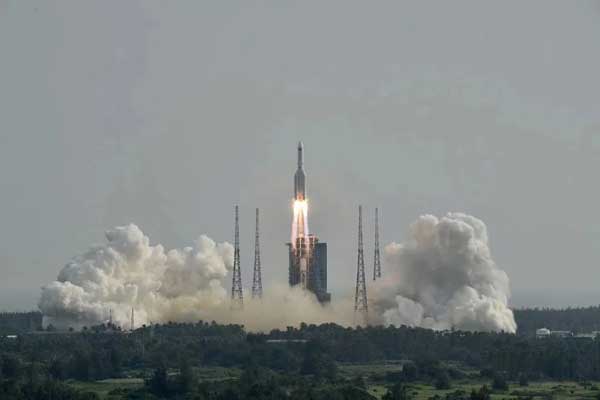
Once the rocket goes up
who cares where it will crash?
It launches 25 tons of mass….
For its first decades as a space power, China located its spaceports inland where they would be more difficult for enemies to destroy in the event of a war. That meant that, like the Soviet Union, spent rocket stages were dropped over land. The hair-raising risks involved have been revealed in recent years as Chinese residents have posted cell phone videos of stages with toxic propellants crashing near residences.
One might think that would not be a problem with China’s newest spaceport, Wenchang, which is located right on the coast. But, you’d be wrong. At least with the massive Long March 5B booster that launches the nation’s largest payloads, like the Mengtian science module that docked with the Tiangong space station today.
Long March 5B’s design means that the entire core stage — about 30 meters long with an empty mass of about 21.5 metric tons (23.8 tons) — enters low orbit. That makes it one of the largest objects ever launched with no way to deorbit it in a controlled way over some remote part of the ocean. The stage continues to circle the Earth getting lower and lower due to atmospheric drag until it reenters and rains debris over some random part of the world.
The Aerospace Corporation has set up a website to track the Long March 5B core stage that launched Mengtian on Monday. As shown in the illustration above, the orbit covers many populated areas. Aerospace is currently estimating it will reenter on Saturday, Nov. 5 at 02:21 UTC, plus or minus 16 hours. Given the uncertainty, it’s too early to predict exactly where it will come down.
To date, there have been no reports of property damage or deaths from previous Long March 5B launches. But, there’s always a first time.
It is true that parts of other rockets have crashed down to Earth. A SpaceX Falcon 9 upper stage that the company didn’t deorbit reentered over the Pacific Northwest with a composite wrapped pressure vessel crashing onto a farm in Washington State. Remains of an unpressurized trunk from a SpaceX Dragon spacecraft were recovered in Australia.
These incidents are worrisome. However, SpaceX has been, on the whole, responsible about deorbiting upper stages, which are much smaller than the Long March 5B core stages. Reports of Dragon truck debris have been rare.
The charge that U.S. criticism of China over Long March 5B is hypocritical is always leveled over Skylab, the abandoned U.S. space station whose remains rained down on Australia after it reentered in 1979. (There were no injuries or deaths.) Skylab’s demise was hardly NASA at its best; the space agency received a lot of justifiable criticism on the matter. If NASA was irresponsible in dealing with Skylab, how does that justify China leaving an entire Long March 5B core stage in orbit?
Hopefully, China will develop a future variant of Long March 5B that will include the ability to safely deorbit over the ocean. In the meantime, keep watching the skies and checking the Aerospace Corporation’s website.

